Cyrus Edwin Dallin
Cyrus Edwin Dallin (November 22, 1861 – November 14, 1944) was an American sculptor best known for his depictions of Native Americans. He created more than 260 works, including the equestrian statue of Paul Revere in Boston, Massachusetts; the Angel Moroni atop Salt Lake Temple in Salt Lake City, Utah; and his most famous work, Appeal to the Great Spirit, at the Museum of Fine Arts, Boston. He was also an Olympic archer.
Cyrus Edwin Dallin | |
|---|---|
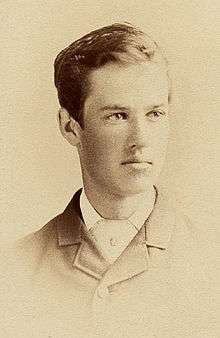 Dallin c.1880 | |
| Born | November 22, 1861 |
| Died | November 14, 1944 (aged 82) |
| Nationality | American |
| Education | Académie Julian |
| Known for | Sculpture |
Notable work | The Angel Moroni (1893) Appeal to the Great Spirit (1908) Paul Revere (1940) |
| Spouse(s) | Vittoria Colonna Murray |
| Medal record | ||
|---|---|---|
| Men's Archery | ||
| Representing the | ||
| Olympic Games | ||
| 1904 St. Louis | Team round | |
Biography

Dallin, the son of Thomas and Jane (Hamer) Dallin, was born in Springville, Utah Territory, although his parents had left The Church of Jesus Christ of Latter-day Saints (LDS Church) before their marriage. At age 19, he moved to Boston to study sculpture with Truman Howe Bartlett. He studied in Paris, with Henri Chapu and at the Académie Julian.[1]
In 1883, he entered the competition for an equestrian statue of Paul Revere for Boston, Massachusetts. He won the competition and received a contract, but six versions of his model were rejected. The fifth model was not accepted because of fundraising problems. The seventh version was accepted in 1939 and the full-size statue was unveiled in 1940.[2][3]
Dallin Converted to Unitarianism and initially turned down the offer to sculpt the angel Moroni for the spire of the LDS Church's Salt Lake Temple. He later accepted the commission and, after finishing the statue said, "My angel Moroni brought me nearer to God than anything I ever did."[4][5] His statue became a symbol for the LDS Church and was the model for other angel Moroni statues on the spires of LDS Church temples.[6]
In Boston, Dallin became a colleague of Augustus St. Gaudens and a close friend of John Singer Sargent. He married Vittoria Colonna Murray in 1891, and returned to Utah to work on The Angel Moroni (1893). He taught for a year at the Drexel Institute in Philadelphia, Pennsylvania, while completing his Sir Isaac Newton (1895) for the Library of Congress. In 1897, he traveled to Paris, and studied with Jean Dampt. He entered a Don Quixote statuette in the Salon of 1897, and The Medicine Man in the Salon of 1899 and the Exposition Universelle (1900).[1] The couple moved to Arlington, Massachusetts in 1900, where they lived for the rest of their lives and raised three sons.
At the 1904 Summer Olympics in St. Louis, Missouri, Dallin competed in archery, winning the bronze medal in the team competition.[7] He finished ninth in the Double American round and 12th in the Double York round.[8]
From 1899 to 1941, he was a member of the faculty of Massachusetts Normal Art School (now the Massachusetts College of Art and Design). In 1912, he was elected into the National Academy of Design as an Associate member, and became a full Academician in 1930. When he died in 1944 his life was celebrated in a Unitarian service.[9]
The Epic of the Indian
Dallin created a four-piece equestrian series called The Epic of the Indian, consisting of Signal of Peace, or “The Welcome” (1890); The Medicine Man, or “The Warning” (1899); Protest of the Sioux, or “The Defiance” (1904); and Appeal to the Great Spirit (1908).[10][11]
A Signal of Peace was exhibited at the 1893 World's Columbian Exposition, and was installed in Chicago's Lincoln Park in 1894. The Medicine Man was exhibited at the 1899 Paris Salon, and the 1900 Exposition Universelle in Paris, where it won a gold medal.[12] It was installed in Philadelphia's Fairmount Park in 1903.
The full-size staff version of Protest of the Sioux was exhibited at the 1904 Louisiana Purchase Exposition, where it won a gold medal. The mounted brave defiantly shaking his fist at an enemy was never cast as a full-size bronze, and survives only in statuette form. A one-third-size bronze version, cast in 1986, is at the Springville Museum of Art in Springville, Utah.[13]
Appeal to the Great Spirit became an icon of American art, and is Dallin's most famous work.[14] The full-size version was cast in bronze in Paris, and won a gold medal at the 1909 Paris Salon. It was installed outside the main entrance to the Boston Museum of Fine Arts in 1912. Smaller versions of the work are in numerous American museums and in the permanent collection of the White House.
In 1929, a full-sized bronze version of Appeal to the Great Spirit—personally overseen and approved by Dallin— was installed in Muncie, Indiana, at the intersection of Walnut and Granville Streets, and is considered by many Munsonians to be a symbol of their city. A one-third-size plaster version was given to Tulsa, Oklahoma's Central High in 1923. It stood in the school's main hall until 1976, when Central closed its doors.[15] In 1985, that plaster was used to cast a one-third-size bronze version, which is now in Woodward Park (Tulsa), at the intersection of 21st & Peoria Streets.[16] There is also a version at St. John University in Wisconsin.
- A Signal of Peace (1890), Lincoln Park, Chicago, Illinois
 The Medicine Man (1899), Fairmount Park, Philadelphia, Pennsylvania
The Medicine Man (1899), Fairmount Park, Philadelphia, Pennsylvania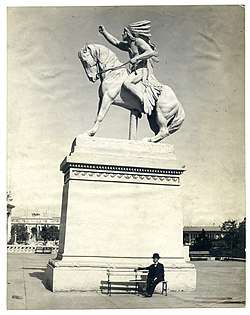 Protest of the Sioux (1904), at the 1904 St. Louis World's Fair
Protest of the Sioux (1904), at the 1904 St. Louis World's Fair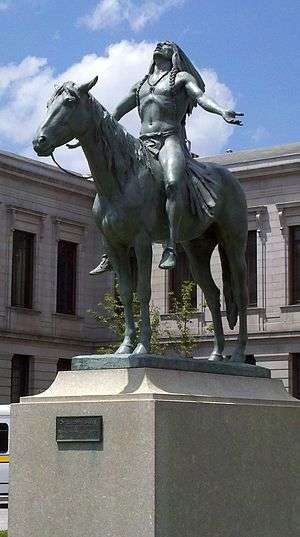 Appeal to the Great Spirit (1908), Museum of Fine Arts, Boston, Massachusetts
Appeal to the Great Spirit (1908), Museum of Fine Arts, Boston, Massachusetts
Legacy
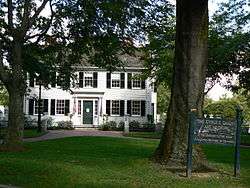
The Jefferson Cutter House in Arlington, Massachusetts, is a museum devoted to his works.[17]
An elementary school in Arlington is named for him.[18]
The Taylor-Dallin House in Arlington, Massachusetts, where Dallin and his family lived is a privately owned residence and has not been listed on the National Register of Historic Places.
More than 30 of Dallin's works are on display at the Springville Museum of Art in his birthplace of Springville, Utah.[2] The Dallin House at 253 S. 300 East in Springville, Utah, is listed on the National Register of Historic Places.
Dallin's papers are at the Smithsonian Archives of American Art.[19]
Selected works
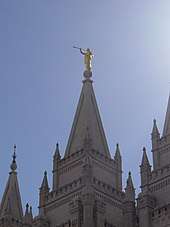
- Model for Equestrian Statue of Lafayette (1889), Smithsonian American Art Museum, Washington, DC
- The Angel Moroni (1893), atop Salt Lake Temple, Salt Lake City, Utah.
- Brigham Young Monument (1893), Main and South Temple Streets, Salt Lake City, Utah.[20][21]
- Sir Isaac Newton (1895), Main Reading Room, Library of Congress, Washington, DC
- Don Quixote de La Mancha: The Knight of the Windmill (1898), Springville Museum of Art, Springville, Utah[21][22]
- Equestrian statue of Paul Revere (1899, dedicated 1940), Paul Revere Mall, opposite Old North Church, Boston, Massachusetts.
- View of Hobble Creek (ca 1900), Utah Museum of Fine Arts, Salt Lake City, Utah.[23]
- Eli Whitney Tablet (1902), Richmond County Courthouse, Augusta, Georgia.[24]
- The Pickett (1905), Battle of Hanover, Hanover, Pennsylvania.[25]
- Victory (1909), Pioneer Park, Provo, Utah.[26]
- General Winfield Scott Hancock (1909–10), Pennsylvania State Memorial, Gettysburg Battlefield, Gettysburg, Pennsylvania.[27][28]

- Soldiers' and Sailors' Monument (1909–1911), Clinton Square, Syracuse, New York.[29]
- My Boys (c. 1910), Robbins Memorial Library, Arlington, Massachusetts.
- Robbins Memorial Flagstaff (1914), Town Hall, Arlington, Massachusetts.
- Anne Hutchinson (1915, dedicated 1922), Massachusetts Statehouse, Boston, Massachusetts.[30]
- Governor William Bradford (1920, dedicated 1976), Pilgrim Hall Museum, Plymouth, Massachusetts.[31]
- Pilgrim Tercentenary half dollar (1920)
- Signing the Mayflower Compact (1921), Provincetown, Massachusetts
- Memory (1924), Sherborn War Memorial, Sherborn, Massachusetts.
- Spirit of Life (1929). Springville Museum of Art, Springville, Utah
- Pioneer Women of Utah (1931), Springville Museum of Art, Springville, Utah.
- Memorial to The Pioneer Mothers of Springville (1932), Springville City Park, Springville, Utah.[32]
Native American works
- A Signal of Peace (1890), Lincoln Park, Chicago, Illinois.
- The Medicine Man (1899), Fairmount Park, Philadelphia, Pennsylvania.
- Protest of the Sioux (1904).[33]
- A one-third-size bronze version (cast 1986) is in the Springville Museum of Art in Springville, Utah.[34]
- Appeal to the Great Spirit (1909), Boston Museum of Fine Arts, Boston, Massachusetts.
- A one-third-size bronze version is in Muncie, Indiana.[35]
- A one-third-size plaster version, and a 1985 bronze version (cast from that plaster) are in Tulsa, Oklahoma.
- The Scout (1910, dedicated 1922), Penn Valley Park, Kansas City, Missouri.
- A one-third-size bronze version is in Seville, Spain; a 1992 gift from Seville's sister-city, Kansas City, Missouri.[36]
- Chief Joseph (1911), New York Historical Society, New York City.
- Menotomy Indian Hunter (1911), Robbins Memorial Gardens, Arlington, Massachusetts.
- Massasoit (1920), Coles Hill, opposite Plymouth Rock, Plymouth, Massachusetts.
- Other casts are at Utah State Capitol, Salt Lake City, Utah; Brigham Young University, Provo, Utah; Springville Museum of Art, Springville, Utah; Mill Creek Park, Kansas City, Missouri; and Dayton Art Institute, Dayton, Ohio.
- On the Warpath #28 (c. 1920), Utah Museum of Fine Arts, Salt Lake City, Utah.[37] and Brookgreen Garden Museum, Brookgreen, South Carolina.
- Passing of the Buffalo, also known as The Last Arrow (1929), Muncie, Indiana.
Gallery
- Model for Lafayette (1889), Smithsonian American Art Museum, Washington, DC
 Sir Isaac Newton (1895), Library of Congress, Washington, DC
Sir Isaac Newton (1895), Library of Congress, Washington, DC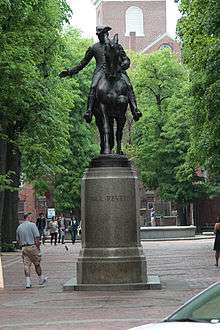 Paul Revere (1899, dedicated 1940), Boston, Massachusetts, near Old North Church
Paul Revere (1899, dedicated 1940), Boston, Massachusetts, near Old North Church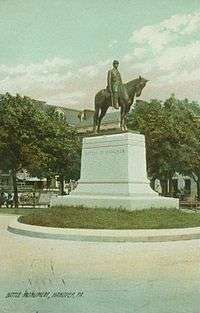 The Picket (1905), Battle of Hanover, Hanover, Pennsylvania
The Picket (1905), Battle of Hanover, Hanover, Pennsylvania Soldiers' and Sailors' Monument (1909–1911), Clinton Square, Syracuse, New York
Soldiers' and Sailors' Monument (1909–1911), Clinton Square, Syracuse, New York- Soldiers' and Sailors' Monument detail
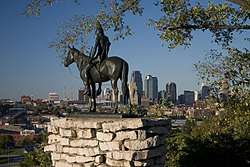 The Scout (1910), Penn Valley Park, Kansas City, Missouri
The Scout (1910), Penn Valley Park, Kansas City, Missouri- My Boys (c. 1910), Robbins Memorial Library, Arlington, Massachusetts
 Chief Joseph (1911), New York Historical Society, New York City
Chief Joseph (1911), New York Historical Society, New York City- Menotomy Indian Hunter (1911), Robbins Park, Arlington, Massachusetts
 Robbins Memorial Flagstaff (1914), Town Hall, Arlington, Massachusetts
Robbins Memorial Flagstaff (1914), Town Hall, Arlington, Massachusetts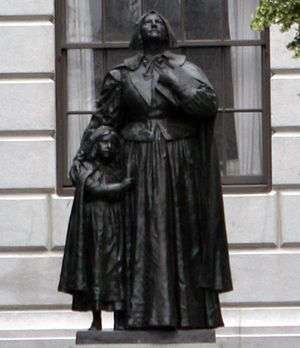 Anne Hutchinson (1915, dedicated 1922), Massachusetts Statehouse, Boston, Massachusetts
Anne Hutchinson (1915, dedicated 1922), Massachusetts Statehouse, Boston, Massachusetts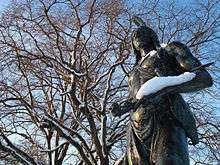 Massasoit (1920), opposite Plymouth Rock, Plymouth, Massachusetts
Massasoit (1920), opposite Plymouth Rock, Plymouth, Massachusetts
 Signing the Mayflower Compact (1921), Provincetown, Massachusetts
Signing the Mayflower Compact (1921), Provincetown, Massachusetts- Memory (1924), Sherborn War Memorial, Sherborn, Massachusetts
- Memorial to the Pioneer Mothers of Springville (1932), Springville, Utah
References
- "Cyrus Dallin: American Sculptor". Harvardsquarelibrary.org. November 14, 1944. Archived from the original on March 4, 2012. Retrieved February 12, 2012.
- "Springville Museum of Art". Sma.nebo.edu. Archived from the original on September 30, 2011. Retrieved February 12, 2012.
- "Utah History Encyclopedia". Media.utah.edu. Archived from the original on January 10, 2012. Retrieved February 12, 2012.
- Levi Edgar Young, “The Angel Moroni and Cyrus Dallin”, Improvement Era, April 1953, p. 234.
- "Sculptor’s Works Top Temple Towers Worldwide", Ensign, April 2006.
- Broder, Patricia Janis; McCracken, Harold (1974). Bronzes of the American West. New York: Harry N. Abrams. ISBN 978-0-8109-0133-9. OCLC 640913.
- Cyrus Dallin Olympic medals and stats Archived August 25, 2007, at the Wayback Machine at www.databaseolympics.com
- "Archery - Cyrus Edwin Dallin (United States) : season totals". The-sports.org. September 21, 1904. Retrieved February 12, 2012.
- https://www.heraldextra.com/sanpete-county/news/cyrus-dallin-and-the-angel-moroni/article_bd84591c-5b51-5b5d-8946-64d256a98c8b.html
- Edward Livermore Burlingame; Robert Bridges; Harlan Logan, eds. (1915). Scribner's magazine. 57.
- "Sculpture". Hoodmuseum.dartmouth.edu. Retrieved February 12, 2012.
- "Cyrus Dallin - American Sculptor". Bronze-gallery.com. Retrieved February 6, 2014.
- "The Protest". Smofa.org. Archived from the original on February 22, 2014. Retrieved February 6, 2014.
- Appeal to the Great Spirit from Boston Public Art.
- "Tulsa Central High School Foundation Projects". Tulsacentralalumni.org. February 21, 2003. Retrieved February 12, 2012.
- "Appeal to the Great Spirit, (sculpture)". Siris
- "The Cyrus E. Dallin Art Museum". dallin.org. Retrieved July 28, 2014.
- "Dallin Elementary School". Arlington.k12.ma.us. Retrieved February 12, 2012.
- Archives of American Art. "Summary of the Cyrus Edwin Dallin papers, 1883–1970 | Archives of American Art, Smithsonian Institution". Aaa.si.edu. Retrieved February 12, 2012.
- The Mormon metropolis: an illustrated guide to Salt Lake City and its environs. Magazine Printing Co. 1899. p. 38.
- . Encyclopædia Britannica (11th ed.). 1911.
- "Don Quixote de La Mancha: The Knight of the Windmill". Springville Museum of Art. Archived from the original on August 19, 2014. Retrieved August 18, 2014.
- Utah Museum of Fine Arts. "View of Hobble Creek". Collections.umfa.utah.edu. Archived from the original on October 21, 2013. Retrieved February 6, 2014.
- The Whitney Tablet Archived November 3, 2010, at the Wayback Machine, retrieved from the National Textile Association Website, February 9, 2009
- "Battle of Hanover Marker". Hmdb.org. Retrieved February 12, 2012.
- "Indian War Memorial". Markers and Monuments Database. Utah State History. Archived from the original on June 26, 2013. Retrieved June 1, 2013.
- General Hancock from SIRIS.
- "General Hancock". Archived from the original on October 21, 2013. Retrieved February 6, 2014.
- Syracuse Soldiers & Sailors Monument from SIRIS.
- Anne Hutchinson from SIRIS.
- Governor Bradford from SIRIS.
- "The Pioneer Mother". Markers and Monuments Database. Utah State History. Archived from the original on July 8, 2012.
- The Protest Archived July 5, 2012, at the Wayback Machine from Northeast Fine Arts.
- The Protest, from SIRIS.
- Muncie Appeal from SIRIS.
- Tim Janicke, City of Art: Kansas City's Public Art (Kansas City, MO: Kansas City Star Books, 2001), p. 15. ISBN 0-9709131-8-4
- Utah Museum of Fine Arts. "On the Warpath #28". Collections.umfa.utah.edu. Archived from the original on October 21, 2013. Retrieved February 6, 2014.
External links
| Wikimedia Commons has media related to Cyrus Edwin Dallin. |
| Wikisource has the text of a 1920 Encyclopedia Americana article about Cyrus Edwin Dallin. |
- Works by or about Cyrus Edwin Dallin at Internet Archive
- Works from the Permanent Collection of the Utah Museum of Fine Arts at Archive.today (archived December 12, 2012)
- The Cyrus E. Dallin Art Museum, Arlington, Massachusetts
- Springville Museum of Art , Springville, Utah
- Biography from the Springville Museum of Art in Utah at the Wayback Machine (archived July 28, 2011)
- from 1943 Class of Central High